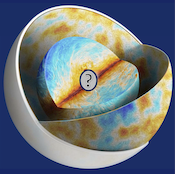SPT-3G, the third-generation camera on the South Pole Telescope, observes cosmic microwave background (CMB) anisotropies with arcminute resolution and 4.5muKarcmin coadded noise in temperature. Recent analyses of polarization data from the 2019 and 2020 seasons have yielded the most precise reconstruction of the E-mode spectrum above ell = 2000 and the CMB lensing spectrum above L = 350. From...
The detection of primordial tensor modes, i.e. gravitational waves, through primordial CMB B-modes is considered the smoking gun signal for inflation. However, in order to solidify this conclusion, we need to insure that other primordial mechanisms do not produce the same signal. To that end, primordial gravitational vector modes (V-modes) and their sourcing of primordial magnetic fields...
Clusters of galaxies, formed at the latest stages of structure formation, constitute unique cosmological probes and are sensitive to cosmological parameters related to structure formation like the rms of matter fluctuations. With the advent of large CMB surveys like those from the Planck satellite, the ACT and SPT telescopes, we now have access to large catalogs of galaxy clusters detected at...
I will introduce the CCAT collaboration which has built the Fred Young Submillimeter Telescope (FYST, pronounced feast). I’ll provide an overview of the first generation instruments being deployed on FYST and their science goals. I’ll conclude with a discussion of the state of the CCAT collaboration and our timelines.
The Epoch of Reionisation imprints its history and morphology on the Cosmic Microwave Background temperature and polarisation anisotropies through two effects: The kinetic Sunyaev Zel'dovich (kSZ) effect and Thomson scattering. I present an analytical approach to derive consistently the angular power spectra of the three main resulting imprints that are the spatial fluctuations of the Thomson...
Historically disregarded as a foreground contaminant, the kinetic Sunyaev-Zel'dovich (kSZ) effect has seen a surge of interest in recent years as an additional cosmological probe. Arising from interactions between CMB photons and free electrons in ionised bubbles, the kSZ signal contains information about the timeline and morphology of Reionisation, a critical, yet poorly understood, period...
CMB-S4 is conceived by a broad community as the path forward to realizing the enormous potential of CMB measurements for understanding the origin and evolution of the Universe, from the highest energies at the dawn of time through the growth of structure to the present day. The most efficient strategy to reach these science goals is to combine two complementary sky surveys: an ultra-deep...

